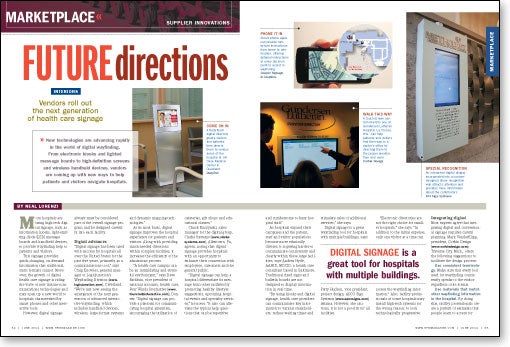Future directions

New technologies are advancing rapidly in the world of digital wayfinding. From electronic kiosks and lighted message boards to high-definition screens and wireless handheld devices, vendors are coming up with new ways to help patients and visitors navigate hospitals.
More hospitals are using high-tech digital signage, such as information kiosks, light-emitting diode (LED) message boards and handheld devices, to provide wayfinding help to patients and visitors.
This signage provides quick-changing, on-demand information that traditional, static formats cannot. Moreover, the growth of digital health care signage is riding the wave of new instant-communications technologies and may open up a new world to hospitals characterized by smart phones and other interactive tools.
However, digital signage always must be considered part of the overall signage program and be designed carefully into each facility.
Digital advances
"Digital signage has been used with success by hospitals all over the United States for the past five years, primarily as a communications tool," says Craig Knowles, general manager of LogicJunction's Wayfinding Division (www.logicjunction.com), Cleveland. "We're just now seeing the emergence of the next generation of advanced interactive wayfinding, which includes handheld devices, wireless, large-format systems and dynamic mapping technologies."
At its most basic, digital signage improves the hospital experience for patients and visitors. Along with providing much-needed directions within complex facilities, it increases the efficiency of the admissions process.
"A health care campus can be an intimidating and stressful environment," says Dave Rathbun, vice president of national accounts, health care, Four Winds Interactive (www.fourwindsinteractive.com), Denver. "Digital signage can provide a platform for communicating hospital amenities, encouraging the utilization of cafeterias, gift shops and educational classes."
Chuck Kuczynski, sales manager for the digital group, Clarke Systems (www.clarkesystems.com), Allentown, Pa., agrees, noting that digital signage provides hospitals with an opportunity to enhance their connection with employees, customers and the general public.
"Digital signage can help a hospital differentiate its message from other facilities by promoting healthy lifestyle suggestions, upcoming hospital events and specialty services," he notes. "It also can alleviate the typical help questions that can be repetitive and cumbersome to busy hospital staff."
As hospitals expand their campuses and the patient, staff and visitor populations become more ethnically diverse, it is getting harder to communicate consistently and clearly within these large facilities, says Andrea Hyde, AAHID, MDCID, a health care consultant based in Baltimore. Traditional fixed signs and bulletin boards are not designed to display information in real time.
"By using kiosks and digital signage, health care providers can communicate key information to various stakeholders, reduce waiting times and stimulate sales of additional services," she says.
Digital signage is a great wayfinding tool for hospitals with multiple buildings, says Patty Hudson, vice president, project design, APCO Sign Systems (www.apcosigns.com), Atlanta. However, she cautions, it is not a good fit for all facilities.
"Electronic directories are not the right choice for smaller hospitals," she says. "In addition to the initial expense, only one visitor at a time can access the wayfinding information." Also, facility professionals at some hospitals may install high-tech systems for the wrong reason: to look technologically progressive.
Integrating digital
Most experts agree that integrating digital and conventional signage requires careful planning. Mark VanderKlipp, president, Corbin Design (www.corbindesign.com), Traverse City, Mich., offers the following suggestions to facilitate the design process:
Use consistent terminology. Make sure that every tool used for wayfinding consistently speaks to the visitor regardless of its format.
Use materials that match other wayfinding information in the hospital. By doing that, facility professionals create a pattern of elements that people learn to access for information. Use of color, typography and accents such as wood or aluminum should keep the wayfinding system visually consistent.
Update content on a regular basis. A team should meet regularly to keep electronic signage updated, by creating content based on patient needs and projecting a positive message as part of the hospital's brand.
"Interactive elements provide almost limitless opportunities to put information in the public realm," VanderKlipp says. "This information can become visual noise if not managed properly."
Kelly David, director of marketing and product management for ASI Sign Systems (www.asisignage.com), Dallas, agrees, noting that digital signage should integrate within the facility and complement the building's architecture.
"In any project, the goal should be to work with the facility's natural wayfinding elements and incorporate signage as needed," she says. "Best practices have been derived from studies on the proper use of signage; those practices apply to any sign, digital or static."
The Americans with Disabilities Act compliance is another consideration. For example, facility professionals should ask such questions as: Should signage include Braille and tactile letters?
"Such considerations carry over to content displayed on the screen," David notes. "Make sure good color contrast and font selection is used to ensure legibility. This ties into the demographics of the facility."
Another key issue is the use of technologies for limited English proficiency (LEP), according to Randy Cooper, president, Cooper Signage & Graphics (www.signsystems.org), Atlanta. LEP encompasses hospital patients and visitors who do not speak English as a first language; it also extends to people with low reading levels.
"When a person with a second-grade reading level is faced with medical terms such as 'otolaryngology,' technology can help bring communication to the lowest common denominator," Cooper notes. "Icons/pictograms and language targeted at low reading levels help provide clarity."
Screens and kiosks
Larger, thinner and multilayered screens are becoming more prevalent in hospitals, experts agree.
"As the price of large [liquid crystal display] and LED screens falls, we are seeing larger screens being installed in hospitals," says Will Pymm, president, RedyRef (www.redyref.com), Long Island City, N.Y. Where 15-inch and 17-inch monitors used to be the norm, 22-inch to 32-inch monitors (and even 65-inch monitors) are becoming common.
High-definition (HD) technology has progressed to the point where these displays can offer multilayered information — providing policy information, upcoming events, service line promotion and patient education along with live television in a split-screen format, according to Cooper.
"The software that drives HD displays allows for flexible content scheduling, ensuring that information displayed is up-to-date," he notes.
David predicts that screen sizes will continue to evolve into thinner formats. "Over the next few years, we will see paper-thin screens that can be utilized in digital signage applications at an affordable price," she notes. "This will open up opportunities for additional implementation of digital signage. A slimmer, lighter profile will allow installation in new areas."
With renewed emphasis on improving the patient experience, interactive kiosks are being used as registration centers in hospitals, just as they are at airports worldwide.
"Along with wayfinding information, interactive kiosks have started to serve other roles including patient registration, medical-treatment updates and limited Internet and e-mail access in waiting rooms," says Chip Floyd, vice president of marketing, Innerface Architectural Signage (www.innerfacesign.com), Atlanta.
Natalie Bobila, vice president, marketing and sales, Interactive Touchscreen Solutions (www.itouchinc.com), Crofton, Md., agrees. "Self-check-in and registration kiosks are the latest hospital applications," she says. "We're seeing a huge wave of self-service applications such as ATMs, grocery store check-outs and airport check-ins. Allowing patients to self-register at hospitals is part of that trend."
Infrastructure needs
As for the installation of digital signage systems, experts say there are no special infrastructure requirements beyond typical power and network connections for PCs and displays already installed in facilities.
According to Cooper, however, installation requirements can vary dramatically, with some requiring no additional support and others requiring extensive cabling to achieve full functionality.
"Most need to be mapped out as part of the overall facility wayfinding plan," he says. "Care also must be taken to provide for updates and harmony in the terminology, look and integration of components of the wayfinding system."
VanderKlipp adds that the weight of current hardware often requires that additional blocking be added to walls. Increasingly, electronic signage can be wireless; however, all maps must be oriented properly, depending on the point of view of the user. Also, wireless technology is not always allowed within health care environments, so installation must be carefully mapped out with facilities staff.
"We've seen applications that are hosted remotely, on servers or in the 'cloud,' and provide information via streaming media or downloading to each sign element," he explains. "Information technology departments often want this information to be housed on their own servers; this is a key design constraint when programmers are building the software to run the signage. So it must be addressed early."
RedyRef recently helped UH Case Hospital in Cleveland solve its wayfinding challenge by implementing an innovative system hookup.
"Most facilities of this size have database security restrictions in place," explains Pymm. "One of the issues at UH was how to keep the directory database/content updated with constantly changing staff and relocation to different offices."
The solution was to import essential data from the existing database by building a program that imports it from a secure location on a daily basis. "Instead of connecting to the hospital's existing backbone, we connected to the guest wireless network and had all the wayfinding systems access the secure location on a subdirectory (not the primary network)," he explains. This solved the problem of managing two databases. Now one person updates the hospital database, and the wayfinding system automatically imports that data.
Peeking into the future
Experts agree that the future of digital signage offers some intriguing scenarios.
Knowles predicts that interactive wayfinding will become an integral part of hospitals. "As screens become cheaper and more powerful, the sky is the limit," he says. "In addition to wireless integrated screens, we will see integration with handheld devices, visitor recognition and personal greeting via radio-frequency identification, and automated check-in and registration via near-field tagging."
Bobila envisions individual global positioning system (GPS) devices for patients and visitors preloaded with their entire itinerary mapped out — from their first appointment to their last, and then finally back to the parking lot.
"This information will be downloaded to their smart phone, or a handheld GPS could be loaned to them while on campus," she notes.
Rathbun predicts that technology will enable enhanced access to back-end hospital data, allowing quick retrieval of critical patient health information. "New technology will allow more advanced interactivity with displays throughout the facility, such as screens mounted in patient rooms where the caregiver can pull up information such as vitals as well as instructions for patients," he says.
VanderKlipp sees clunky interfaces, such as quick response codes, being replaced by near-field communication tools that will be integrated into smart phones. As a result, users will be able to access information by merely holding a phone close to a physical signage element.
He also believes that expectations for privacy and access to information will be redefined by these new technologies. "Just as developers focus on capability, they also will need to focus on security so that users are confident their records are protected."
Neal Lorenzi is a freelance writer based in Mundelein, Ill.
| Sidebar - For more information |
| For further details on the wayfinding devices featured in this month's "Marketplace" article, readers can contact the following vendors: »APCO Sign Systems »ASI Sign Systems »Clarke Systems »Corbin Design »Cooper Signage & Graphics »Four Winds Interactive »Innerface Architectural Signage »Interactive Touchscreen Solutions Inc. »LogicJunction Wayfinding Division »RedyRef |




